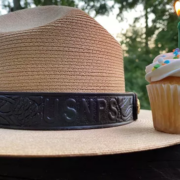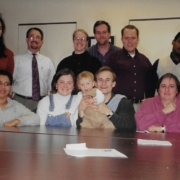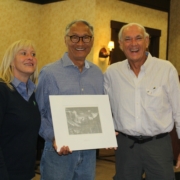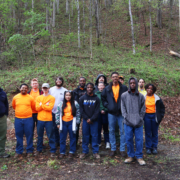
What Corps Movement Advocates Are Saying About the American Climate Corps
This September, the Biden Administration announced the American Climate Corps which will create a new generation of young conservation leaders who will improve communities across the country and strengthen our nation’s climate resiliency.
The American Climate Corps (ACC) will be a vital component of America’s climate agenda, aligning with efforts to reinvigorate the economy by creating thousands of new green jobs and accelerating our country’s transition to a sustainable, clean energy future.
The White House and AmeriCorps have acknowledged that the American Climate Corps announcement would not have been possible if not for the success of the existing network of Service and Conservation Corps and that the ACC will not achieve its goals without the existing network. The Corps Network would like to thank our nearly 150 member Corps for their outstanding services. We would not have reached this point in the Corps movement if it weren’t for Conservation Corps and the thousands of outstanding Corpsmembers in service. To ensure a successful, national ACC initiative, we must invest in young Americans interested in pursuing green career opportunities Corps provide and expand workforce development practices evident in our member Corps.
Here’s what our partners and Corps champions are saying about the American Climate Corps:
– New Mexico Senator Martin Heinrich, 9/20/23:
“As the first AmeriCorps alum in the Senate, I have been calling to create a Climate Corps for years. There is a lot of work to do to solve climate change and build our clean energy future—young Americans are eager to be the heroes in this story. We need to invest in providing them the training and opportunities they need to pursue emerging career fields at the center of building climate solutions. Climate change is one of the greatest challenges we will ever face. But solving it will also be one of the greatest career and wealth creation opportunities in our lifetimes. Through the American Climate Corps—much like the Civilian Conservation Corps of the 1930s—a whole new generation of Americans can step up to restore our lands and waters, install and maintain clean energy infrastructure, and build healthier and more resilient communities.”
– Colorado Congressman Joe Neguse, 9/20/23:
“Since first being elected to Congress, I have proudly championed legislation creating a new 21st century Civilian Climate Corps. One that will work for our generation, while taking inspiration from the program responsible for creating wonders across my home state of Colorado—from the Red Rocks Amphitheater to the countless roads, trails, and campgrounds in Rocky Mountain National Park.”
– Massachusetts Senator Ed Markey, 9/20/23:
“It’s 10pm and I’m still thinking about the magic that I felt in front of the capitol today. From @AOC to the young people organizing with @sunrisemvmt to the countless advocates who fought so hard for a Climate Corps. Today, victory was ours. And tomorrow, we will keep fighting.“
– Senate Majority Leader Chuck Schumer, 9/20/23:
“BIG NEWS: Thanks to the hard work of youth activists across the country, President Biden just announced he’s creating an American Climate Corps. I’ve pushed hard for this. A new climate corps will help create pathways to good-paying green jobs!”
– Chairwoman, Senate Appropriations Committee, Washington Senator Patty Murray, 9/20/23:
“This is great news that’ll turbocharge our investments in clean energy and help us fight the climate crisis—all while creating good-paying jobs in the process!”
– White House National Climate Advisor Ali Zaidi, 9/20/23:
“We’re opening up pathways to good-paying careers, lifetimes of being involved in the work of making our communities more fair, more sustainable, more resilient.“
– United States Secretary of Agriculture Tom Vilsack, 9/20/23:
“@USDA is proud to be a part of this effort through the Forest Corps. A partnership between @ForestService and @AmeriCorps, the Forest Corps is the first major interagency partnership under @POTUS‘ Climate Corps and will support efforts to address the wildfire crisis.”
– Michael Smith, CEO, AmeriCorps, 9/20/23:
“The American Climate Corps represents a new era of youth-powered climate action. With more than 20,000 members, they will help reforest our lands, mitigate the risks of floods and wildfires, support energy efficiency projects, and address extreme heat.”
– Jackie Ostfeld, Founder and Co-Chair / Campaign Director, Outdoors Alliance for Kids / Sierra Club Outdoors for All, 9/20/23:
“The establishment of an American Climate Corps will bring us closer to meeting our national climate and conservation goals, while ensuring the next generation of leaders are at the forefront of solving our climate crisis. This move by the Biden-Harris Administration will dramatically expand the meaningful work youth conservation corps have been doing for years. Whether they’re planting trees to reduce the urban heat island effect, building living shorelines to mitigate the impact of hurricanes, fighting wildfires or building trails, corps provide young leaders with green jobs and meaningful opportunities to transform the health of our planet, people and economy. As we look to implement the most important environmental laws in history – the Inflation Reduction Act and Bipartisan Infrastructure Law – a reinvigorated, well-coordinated ACC is just what we need to get the job done.”
– Heather Clish, Vice President for Conservation & Recreation Advocacy, Appalachian Mountain Club, 9/20/23:
“The Appalachian Mountain Club, the nation’s oldest conservation and recreation organization, supports the Biden Administration’s executive action today. The impacts of climate change are being felt in communities across the country today, so the time is now to mobilize an American Climate Corps to conserve and restore public lands and waters, bolster community resilience, increase reforestation, increase carbon sequestration in the agricultural sector, protect biodiversity, improve access to recreation, and address the changing climate. As a 21st century accredited Conservation Corps through The Corps Network, AMC has first-hand experience in responding to the expanding need and workforce opportunity in sustaining natural resources, public lands, and local communities in the midst of our climate crisis.”
The Corps Network is grateful to represent and support the nearly 150 Service and Conservation Corps operating today that will pave the way in ensuring that the American Climate Corps will create a more climate resilient and equitable America.
Impact Story: AFMO Revives Fort Simcoe Job Corps’ partnership with the Yakama Nation fire organization
Submitted by Alicia Bennett, Public Affairs Officer, U. S. Forest Service Job Corps
It is not uncommon for Job Corps Civilian Conservation Center (CCC) students to radically transform their lives upon entering the program. Unsurprisingly the experience remains with them. That was the case for Fort Simcoe Job Corps Civilian Conservation Center Assistant Fire Management Officer (AFMO) Matthew Ball. He enrolled at Fort Simcoe Job Corps CCC in 2002. His first trade choice was Heavy Equipment Operations Mechanics but it was full. So, he enrolled in Culinary Arts waiting for a slot to open. Job Corps was better than his life before–doing drugs and going nowhere in life. “From the age 15 to 22, my life was a blur of doing drugs and running crazy which left me homeless. I’d hit rock bottom and I had nowhere else to go,” states Ball. “I needed a bed to sleep in. It was a pillow. It was some food.” Ball decided that hanging out at Fort Simcoe Job Corps for a couple of years was a pretty sweet deal.
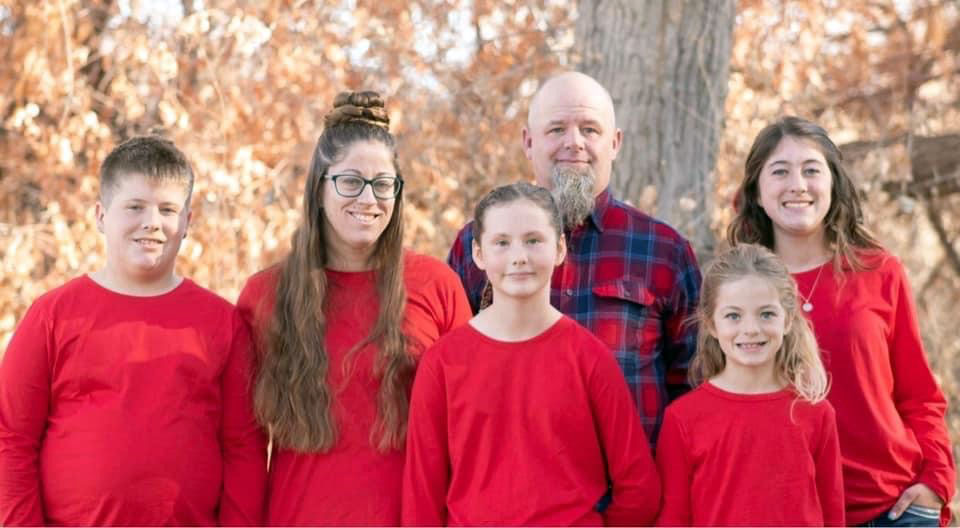
The Matthew Ball Family: (l-r) Samuel, Toni, Lillie may, Matthew, Akemi, and Brianna Ball. Photo courtesy of Matthew Ball.
Established on April 15, 1966, Fort Simcoe was then operated by the Bureau of Reclamation prior to its transfer to Forest Service operations on January 17, 2010. During his enrollment, Fort Simcoe students could work as contract wildland firefighters with the Bureau of Indian Affairs (BIA). After getting a taste of fire, Ball was hooked and requested a transfer to Wolf Creek Job Corps so he could join its Hotshot Crew. There were some twists and turns, but Ball ultimately got a job as a seasonal, graduated from Wolf Creek in 2004 and was accepted an apprenticeship in Region 5. “Sixteen years later, I have a wife, three kids, and I own my own home and yes, I owe it all to Job Corps,” states Ball
Ball sought to promote the interests of the Job Corps students throughout his career. When a position opened up, as a Sequoia National Forest Assistant Captain, he would search for a Job Corps student or graduate to fill it—which often required out-of-the box thinking. “There were issues on the Sequoia with Job Corps students in the past but to me they were minor—the towel shouldn’t have been thrown in. Never give up on anyone trying to be successful,” he shared. “I was never in the position to really sell Job Corps. I am coming to the point in my career where I do want to complete the circle and give back to what has given me life and that is Job Corps.”
Job Corps fire management set out to recruit Ball, giving him a choice off CCCs. Ball did not hesitate in selecting Fort Simcoe despite the sacrifices required of him and his family. It required pulling his 16-year-old daughter and sons, 15 and ten—from everything they’ve known. Ball’s wife was suddenly unemployed with uncertain job prospects. Affordable housing within driving distance of Fort Simcoe suitable for a family was non-existent. For two months, the family lived out of a Fifth Wheel before snagging literally the one house within reach at a price of $320,000—a stretch when you only clear $4,200 a month in salary. “All the kids hobbies were put on hold because I took a pay cut,” shared Ball.

Fort Simcoe and Yakama Nation wildland firefighters stop for a photo in front of the Yakama Nation’s Fire Management Office before heading out to patrol Yakama Nation tribal lands on the Treaty Days holiday weekend in June 2023. Along with patrolling, the firefighters removed brush on a roadway for a thinning project. USDA Forest Service photo by Matthew Ball.
Presently, Fort Simcoe is past its glory days. Ball wants to be part of the change that brings those days back. Key center leadership departed and the center’s relationship with the Yakama Nation died after Fort Simcoe was transferred to the Forest Service. During Ball’s enrollment, nearly half of Fort Simcoe’s students were tribal members and a large percentage of the staff were also members. The Nation sponsored the fire crew and wildland firefighter shirts said BIA. Ball had never lost contact with either Fort Simcoe or the Nation. “When I heard about this job, I called everyone and said, “I’m coming back,” Ball stated. “I want to bring back that partnership where I can get help from them and in return we can help them as well. I want that relationship back with them. The Nation is right here and it is our closes ally.”
Even before the recently announced “Equity Action Plan meant to strengthen Tribal consultations and Nation-to-Nation relationships, Ball’s first priority was re-establishing the center’s partnership with the Yakama Nation.
“Rebuilding our relationship with Job Corps has been beneficial to our fire program,” stated Yakama Nation AFMO Don Jones. “It’s nice to have fire support right out our back door. The Fort Simcoe center director and fire staff have been key to setting this solid foundation.” Partnership opportunities include cross-training, student and overhead assignments on the Nation’s wildland type 6 engine, and Fort Simcoe’s heavy construction equipment operations trade students supporting infrastructure work on Tribal lands.
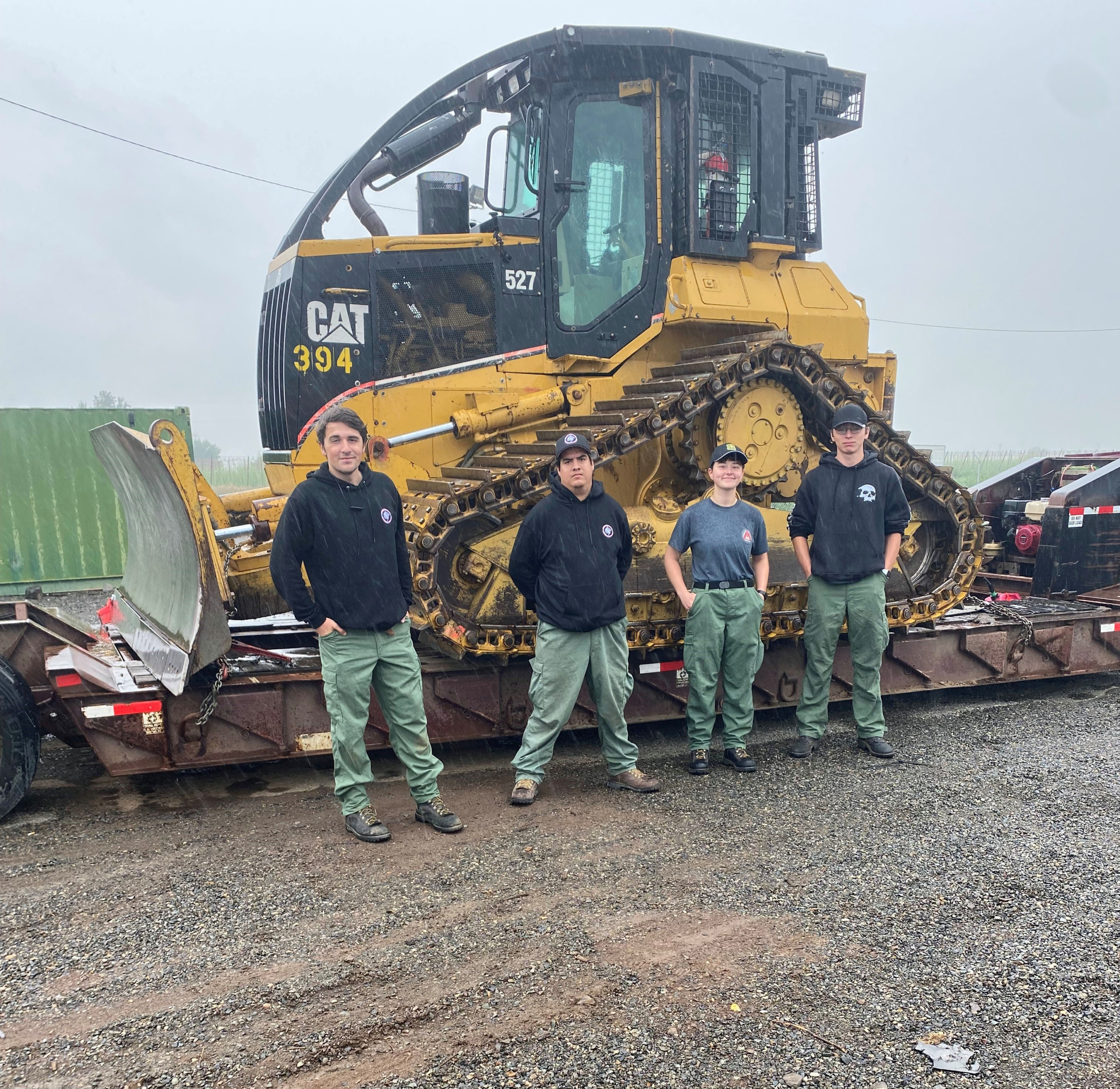
(l-r) Fort Simcoe Job Corps students Nathen Jenson and Thomas Proctor and Columbia Basin Job Corps students Navaeah Gross and Jayson Robbins were part of a five-person module that helped patrol Yakama Nation tribal lands on the Treaty Days holiday weekend in June 2023. Along with patrolling, the Fort Simcoe module worked in close conjunction with the Nation’s fire management resources to remove brush on a roadway for a thinning project. USDA Forest Service photo by Matthew Ball.
Now facing the reality of the challenges Fort Simcoe’s facing, Ball is occasionally nervous. “Will I be successful? With the people who have been here before me I have some big shoes to fill,” he mused. My heart is with Fort Simcoe but I have a lot to lose. But, if I can walk away with a fully functional fire program I will be happy.”
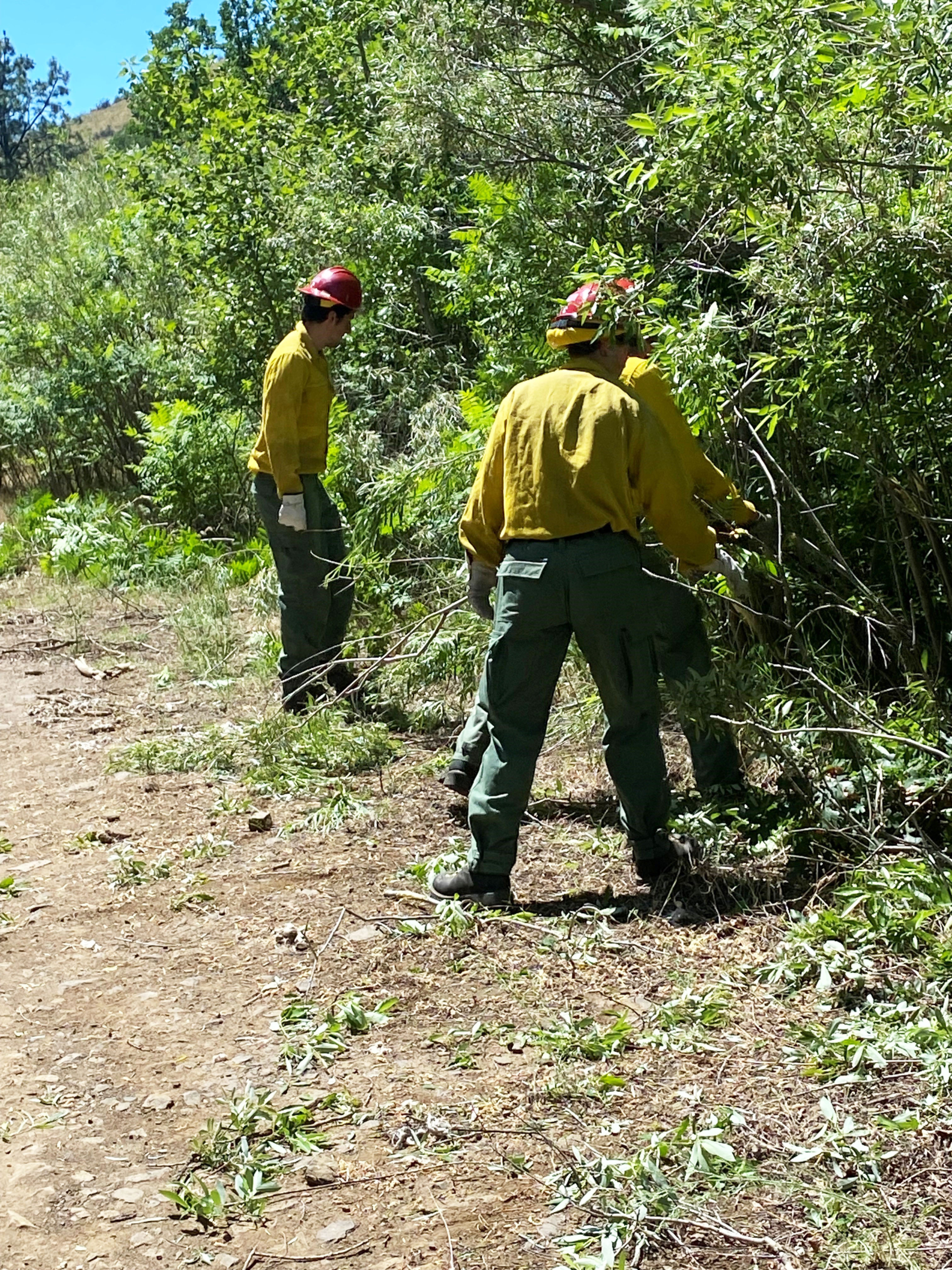
A five-person Fort Simcoe Job Corps fire module removed brush along a roadway for a thinning project and helped patrol Yakama Nation tribal lands during the Nation’s Treaty Days holiday in June 2023. USDA Forest Service photo by Matthew Ball.
Ball is navigating other challenges. Fort Simcoe does not have enough students and wildland firefighting is not a certified trade. Ball borrows his students from other trades and his students are deployed as a militia. One plus is that the students that find their way to him are ranch kids unafraid of hard work. Then there is the typical government bureaucracy including all-day meetings and learning agency procedure to purchase the equipment need for a wildland fire training program. Ball needs to travel the state to sell his program and he still does not have a fire vehicle. “Mine is on order and you know how that works,” he reflected. “I will take anything right now, except for a Prius. I won’t drive a Prius.”
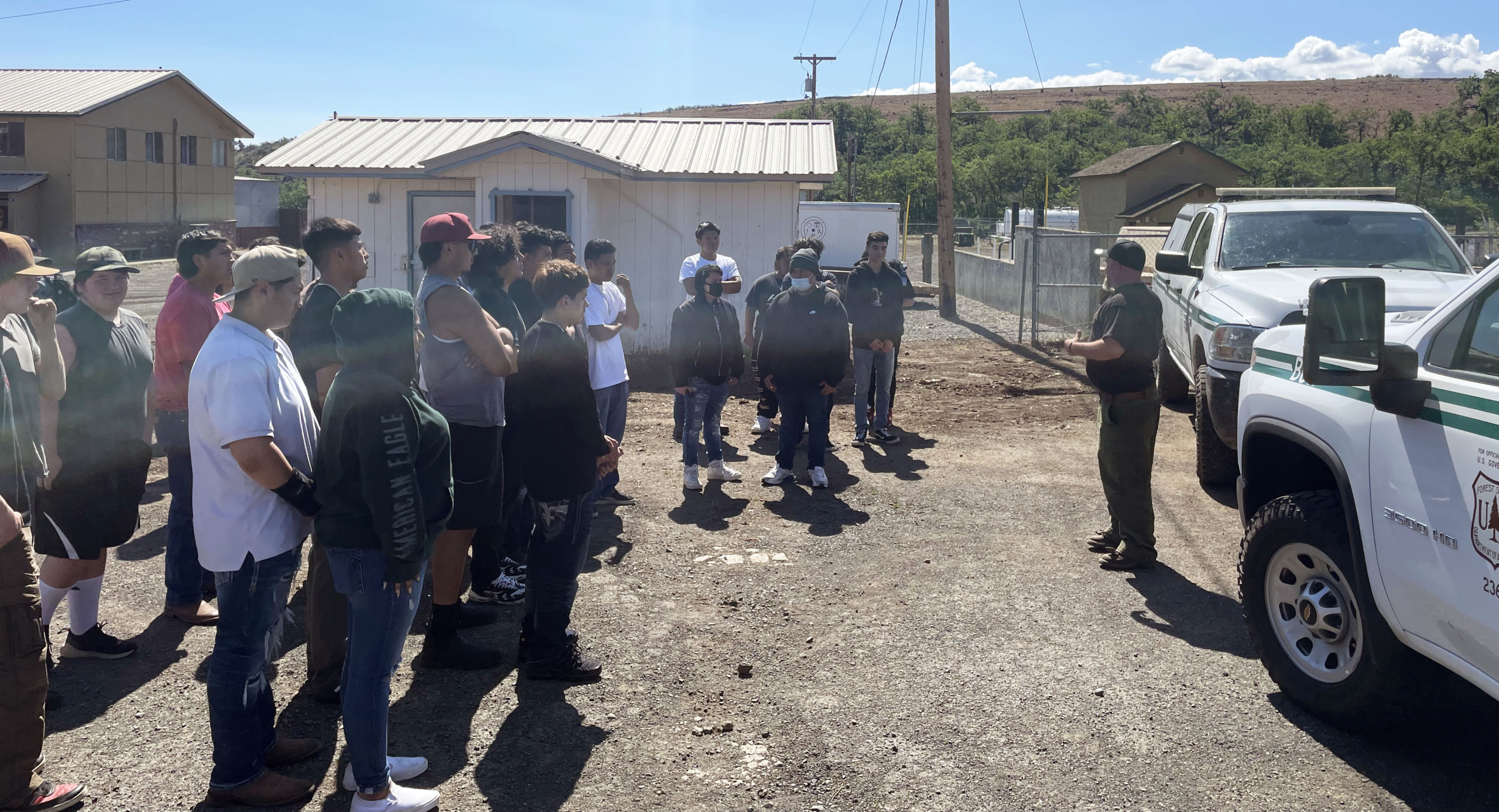
On May 17, 2023, Fort Simcoe Job Corps students gather to learn more about wildland firefighting training and deployment opportunities during a trade day. USDA Forest Service photo by Matt Ball.
When asked what is needed the most to bolster and support the Job Corps program, Ball does not hesitate. “We’ve got to have the staff that has the heart and want to see the change. You have to love this job to do it because the money isn’t there,” he stated. “It’s hard to get the staff here with the amount they are paid. You can really see it here at Fort Simcoe with all job vacancies. There is nothing that anyone can do to really fix this program until they fix the wages.” Despite his own and his family’s sacrifices, Ball has no regrets about his decision accepting the job. “I would not take anything back. This is my life and it was meant to be.”

(l-r) Fort Simcoe Job Corps Assistant Fire Management Officer Matthew Ball and Columbia Basin Job Corps Administrative Support Assistant Lindsey Lopez take advantage of a photo opportunity on April 13, 2023. USDA Forest Service photo by James Harbour.
August 25, 2023 marks the National Park Service’s 107th birthday
By: Halle Lynn
Join us in wishing our partners at the National Park Service a happy birthday on August 25, 2023.
The National Park Service‘s mission is to extend “the benefits of natural and cultural resource conservation and outdoor recreation throughout this country and around the world.” These goals set forth by the National Park Service (NPS) are often carried out through their partnerships with Conservation Corps. As NPS approaches its 107th birthday this August 25th, let’s celebrate how national parks have worked with Corps to improve public lands, the environment, and the lives of Corpsmembers and visitors alike.
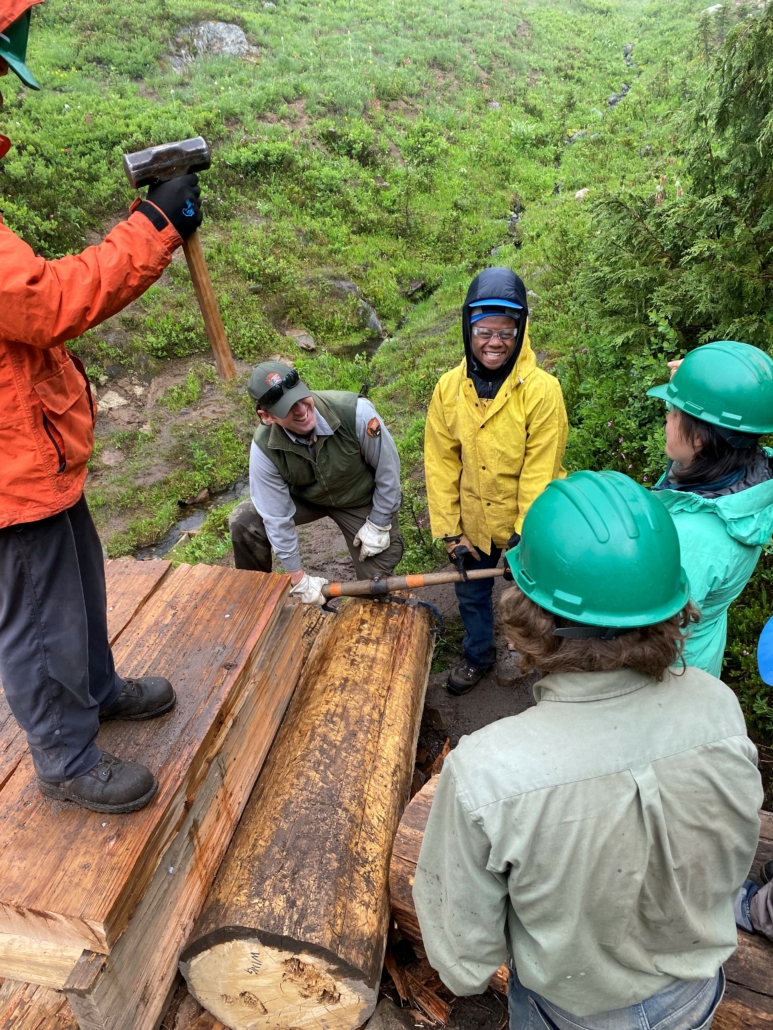
Northwest Youth Crew’s ASL Inclusion Crew at Mt. Rainier National Park
The Corps Network, and many individual Conservation Corps, share a similar mission to NPS with an additional emphasis on the lives and development of young people. Based in different parts of the country, these programs have individual goals with Corps-specific projects. However, whether the projects are basic HVAC maintenance or the evaluation of wildlife habitats, the mission of NPS is a foundational element in the goals and values of each program. Conservation Corps help carry out their missions by providing career and workforce-based skills and education while fostering a community that teaches, appreciates, and gives back to the environment and our public lands. In doing so, they are fostering the next generation of service and conservation leaders and providing safe and accessible public lands.
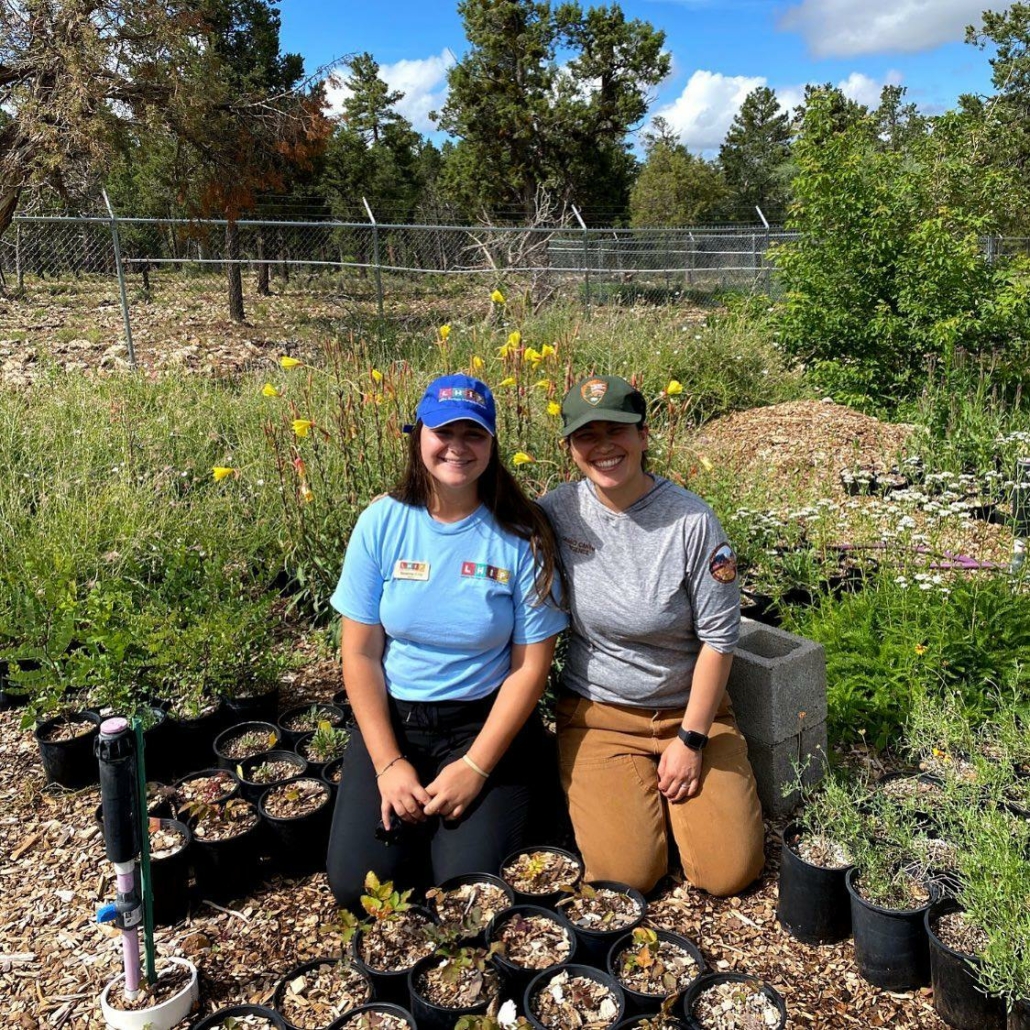
Latino Heritage Internship Program at Grand Canyon National Park
This August, NPS is remembering why they were created. For over a hundred years, the National Park Service has set out to “preserve unimpaired the natural and cultural resources and values of the national park system for the enjoyment, education, and inspiration of this and future generations.” The work of Conservation Corps and the young people who are a part of them, help to move this initiative forward with every project.

Larimer County Conservation Corps at Rocky Mountain National Park
Help celebrate with the National Park Service this August by visiting a national park, participating in their #YourParkStory feature, or engaging in their other social media birthday campaigns. Visit the NPS website for more details.
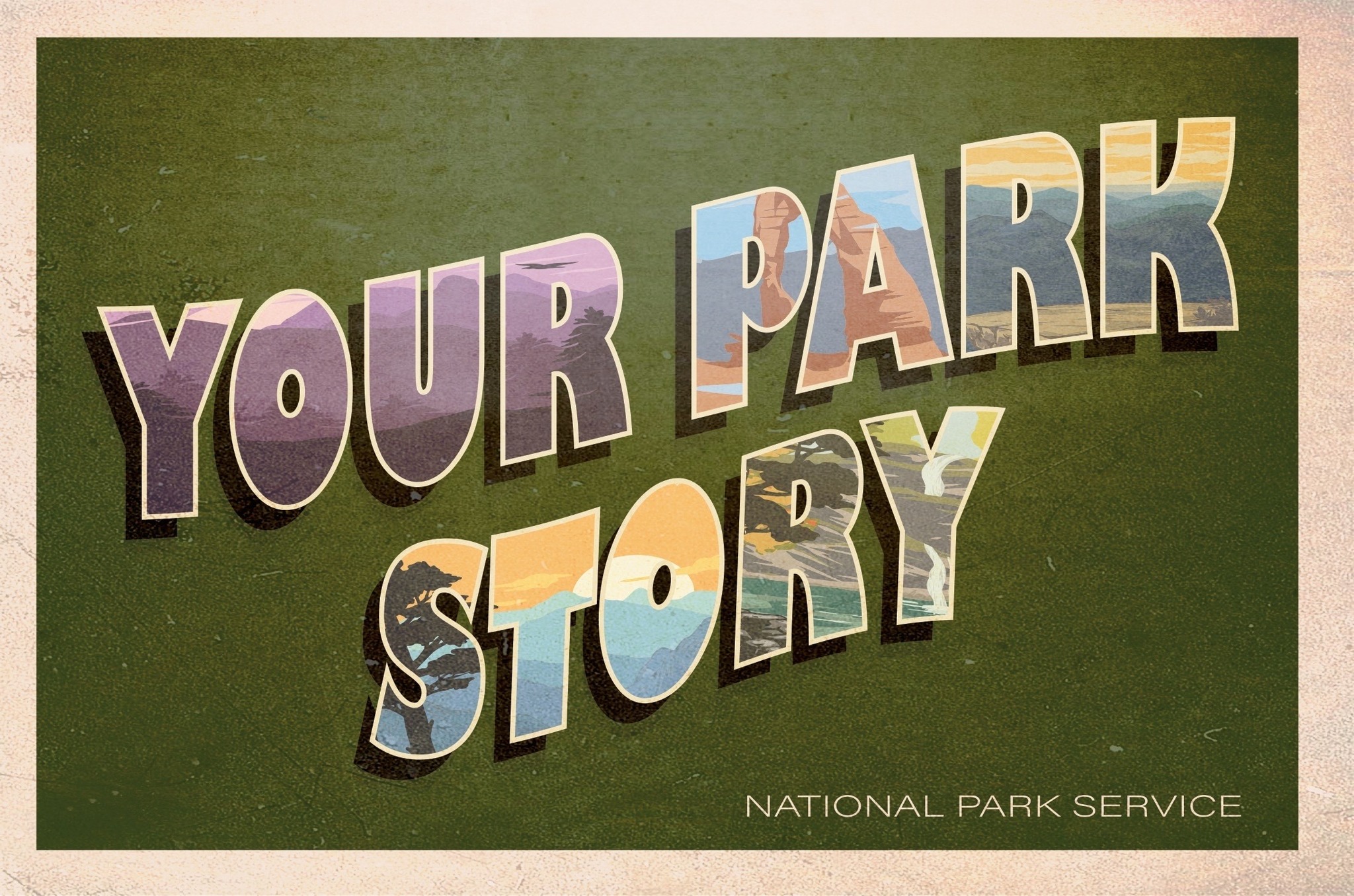
Corps Oral History: Andrew Moore
By: Emma Fantuzzo
About the Corps Oral History Project:
The Corps movement dates to President Franklin D. Roosevelt’s Civilian Conservation Corps (CCC) of the 1930s – ‘40s. The CCC offered young, mostly white, men the opportunity to work and earn money during the Great Depression. The “CCC boys” planted billions of trees, built hundreds of parks, and established a legacy of conservation across the country.
While the CCC certainly provided a framework for modern Corps, it wasn’t until the 1970s and ‘80s that a new, more equitable, and ever-evolving Corps movement began to emerge. This oral history project gathers insights from the dreamers, innovators, and leaders who made today’s network of Service and Conservation Corps possible.
Andy’s Background:
 Andrew Moore was introduced to the Corps movement in 1987 when he joined the Human Environment Center (HEC) as a staff member. At the time, HEC served as the fiscal agent for The Corps Network’s predecessor, the National Association of Service and Conservation Corps (NASCC).
Andrew Moore was introduced to the Corps movement in 1987 when he joined the Human Environment Center (HEC) as a staff member. At the time, HEC served as the fiscal agent for The Corps Network’s predecessor, the National Association of Service and Conservation Corps (NASCC).
“At that point, we had about 40 programs that we knew of around the country. Many of them were statewide programs, there was a tiny spattering of local programs. So that was the beginning, back in ’87.”
Andy went on to work with NASCC for the next 15 years in various roles. In 1988 he staffed a partnership with Public/ Private Ventures called the Urban Corps Expansion Project which set out to build on examples in places like Oakland, San Francisco and LA, to plant Corps in at least 15 cities around the country. Several of these start-up Corps are still active, such as the Greater Miami Service and Conservation Corps.
In the 90s, building on the momentum created during the Bush administration, the Clinton administration brought more attention and resources to National Service with the creation of the Corporation for National Service. During that time, Andy, still working with NASCC, worked on federal agency partnerships and funding flows for Corps.
“We set the wheels in motion beginning in ’93 and ‘94 for increased partnerships between Corps and the National Park Service and to some degree the Forest Service, Fish and Wildlife, and other federal agencies. NASCC took another major step by applying successfully to the US Department of Labor support welfare-to-work “Corps to Career” projects with several member Corps… That was right around 2000, at the peak time of funding for youth employment from the federal government. It’s never been the same since.”
In 2002, Andy left NASCC and began consulting with Corps on strategic planning and partnership development. This led him to begin consulting with the National League of Cities where he currently works as the Director of Youth and Young Adult Connections. Andy continues to look for ways to utilize and expand Corps work.
Andy’s Insights:
Q: What was the Corps Community like when you started? How has it changed?
Andy: If I go all the way back to ’87, the leaders in the Corps world were largely people who had experience in that Jimmy Carter era of the Young Adult Conservation Corps programs at the state level. In the latter half of the 1980s and first half of the 1990s and I think especially through the Urban Corps Expansion Project, we were able to create leadership roles for more people of color, for women, and just really start to diversify what the leadership in staffing of the Corps world looked like.
I think there have been discussions and debates over time about who can best benefit from participation in a Corps. I’d like to think that emphasis on providing opportunities for young people who had less opportunity starting out is a big emphasis in the Corps world. The Corps Network is a major participant in ongoing policy support for opportunity youth, so I am glad to see that. Even the Corporation for National Service has come around after many years of resisting our role in employment and training to embrace that under the current leadership.
Q: Where do you think the Corps movement is headed and what could be improved going forward?
Andy: I’m still interested in, and this goes back to when we started doing training in urban stream restoration 30 years ago – thinking about young people, wondering what Corps can do to strengthen ties with employers or demonstrate that they are really delivering young people credentials and experience that will pay off well in public or private sector jobs after they leave the Corps. I’m imagining that there is still work to do to tighten up the connections. I know that it is difficult work. So that’s one area.
Despite the growth of federal funding and federal partnerships, I think there’s so much need for more Corps. There is a huge population of opportunity youth, five million across the country, and a lot more young people should have a Corps experience. There’s a long way to go to be operating at the scale that we need to be operating.
Sitting where I do at National League of Cities, I’m not sure that we have really maximized the potential for Corps to work with cities. I think the relationship between PowerCorps and the Philadelphia Water Department is a good model of mutually beneficial relationships…as I’ve talked to Corps in recent years, I have the sense that cities are not always welcoming partners and that there are legal barriers in place, and I wish we could do more to break those down and make sure that Corps and cities are working together.
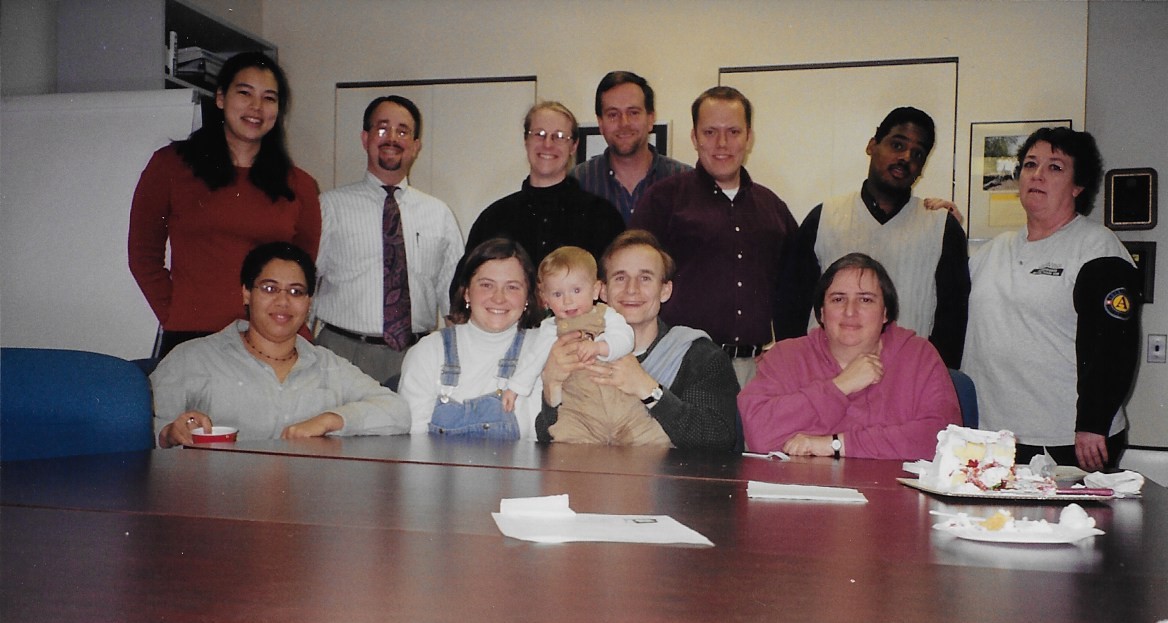
NASCC Staff in 2000, Andy third from left
Q: What do you feel is the effect Corps have on young people’s lives?
Andy: First is the connection to local projects and being able to go back to a site and say, “I contributed to this, I did this.” Second, I think there’s something for crew-based Corps. Strong team identification, and the ability to really connect with a mentor and a crew supervisor. That can pay a lot of dividends. Best case, a chance to complete or advance your education in a way that’s grounded in the actual work experience so that it feels relevant and creates a sense of forward momentum in terms of credentialing and so forth. And creating a consistent source of income, even if small scale. It gives young people on that track the opportunity to earn money.
Q: Do you have any stories from your experiences that you’d like to share?
Andy: In Montana and Arizona we had to go through a couple of rounds to get it right, to get to a structure that would work in each of the states. To have the Corps working in huge geographic areas, a lot of rural space and population concentration, a lot to figure out in terms of how to make a Corps work in those states. Unlike California, which always has forest fires and disasters that contribute to the need for the CCC, those states have been somewhat more insulated from those disasters so they had to figure out working relationships and funding flows that would work. It was gratifying to work alongside them. I was there as an advisor, trying to bring in ideas from other places to help tighten up their thinking, so those were great experiences working in those two states, and both of which as I understand still have a lot of Corps activity.
I wish the Corps community the best. I wish I had more time to connect with people I’ve met over time. Always eager to hear stories of success and challenges and standing ready to help add momentum to the successes and work through the challenges.
Corps Oral History: Bruce Saito
By Emma Fantuzzo
About the Oral History Project:
The Corps movement dates back to President Franklin D. Roosevelt’s Civilian Conservation Corps (CCC) of the 1930s – ‘40s. The CCC offered young, mostly white, men the opportunity to work and earn money during the Great Depression. The “CCC boys” planted billions of trees, built hundreds of parks, and established a legacy of conservation across the country.
While the CCC certainly provided framework for modern Corps, it wasn’t until the 1970s and ‘80s that a new, more equitable, and ever-evolving Corps movement began to emerge. This oral history project gathers insights from the dreamers, innovators, and leaders who made today’s network of Service and Conservation Corps possible.
Bruce’s Background:
Bruce Saito has dedicated the past 47 years of his life to Conservation Corps and is currently Director of the California Conservation Corps (CCC). Bruce grew up in Los Angeles and graduated from San Francisco State University with a degree in Art. His history with the Corps began in 1977 when he was hired to a supervisory position with the CCC. As he put it, “I started my career and never looked back with the Conservation Corps movement.”
Bruce has had a huge impact not only on the CCC but also on the Los Angeles Conservation Corps, which he helped establish in 1986. His work has influenced modern Corps across the country and helped usher in the Corps movement as we know it today. More recently Bruce served as the president of the California Association of Local Conservation Corps and as president of The Corps Network’s Board of Directors. Bruce was awarded The Corps Network’s Corps Legacy Achievement Award in 2014.
“[The Corps] has been a great pleasure and a kind of obsession of mine. It’s amazing.”
Bruce’s Insights:
Q: What was the Corps community like when you started?
Bruce: When I began in 1977, Governor Jerry Brown modeled the CCC a little bit after the Civilian Conservation Corps, but a lot more inclusive. The Civilian Conservation Corps was all boys, men, and it was segregated at that. I think this governor was intent on not only diversifying but being more inclusive. There have been times where the CCC has been probably 30 or 40% women and I think we’re constantly trying to improve. Back then we were coming after the Vietnam War, so the world was upside down.
There was always, especially in California, a strong commitment to the environment. In the 1970s there was a great need for employment of young folks. People wanted to go to school, but some also wanted to serve their communities. So that kind of convergence of doing the natural resource conservation work was still a great need. You know this is the time of Woodstock. The message back then, and still is, is the ability to serve your community, to develop those skills and experiences and at the same time do something good for the environment.
Q: What would you say has been the biggest change you’ve seen since you began?
Bruce: What’s changed I think is how we approach young folks and the message that really resonates with folks to get them to make that commitment. I’m still trying to figure out post-pandemic, what really motivates young folks. I still think that it doesn’t matter which generation you’re from, we’re looking for that little spark in each person that they want to really contribute, they want to pay it forward.
The environmental issues might change from 40 years ago – maybe it was water, and then it was clean air, and now it’s certainly climate – but it’s all related to the environment. I think that’s not been a change, but something that’s been consistent. Some of the venues change, some of the priorities change, but the constant is this commitment to the environment.
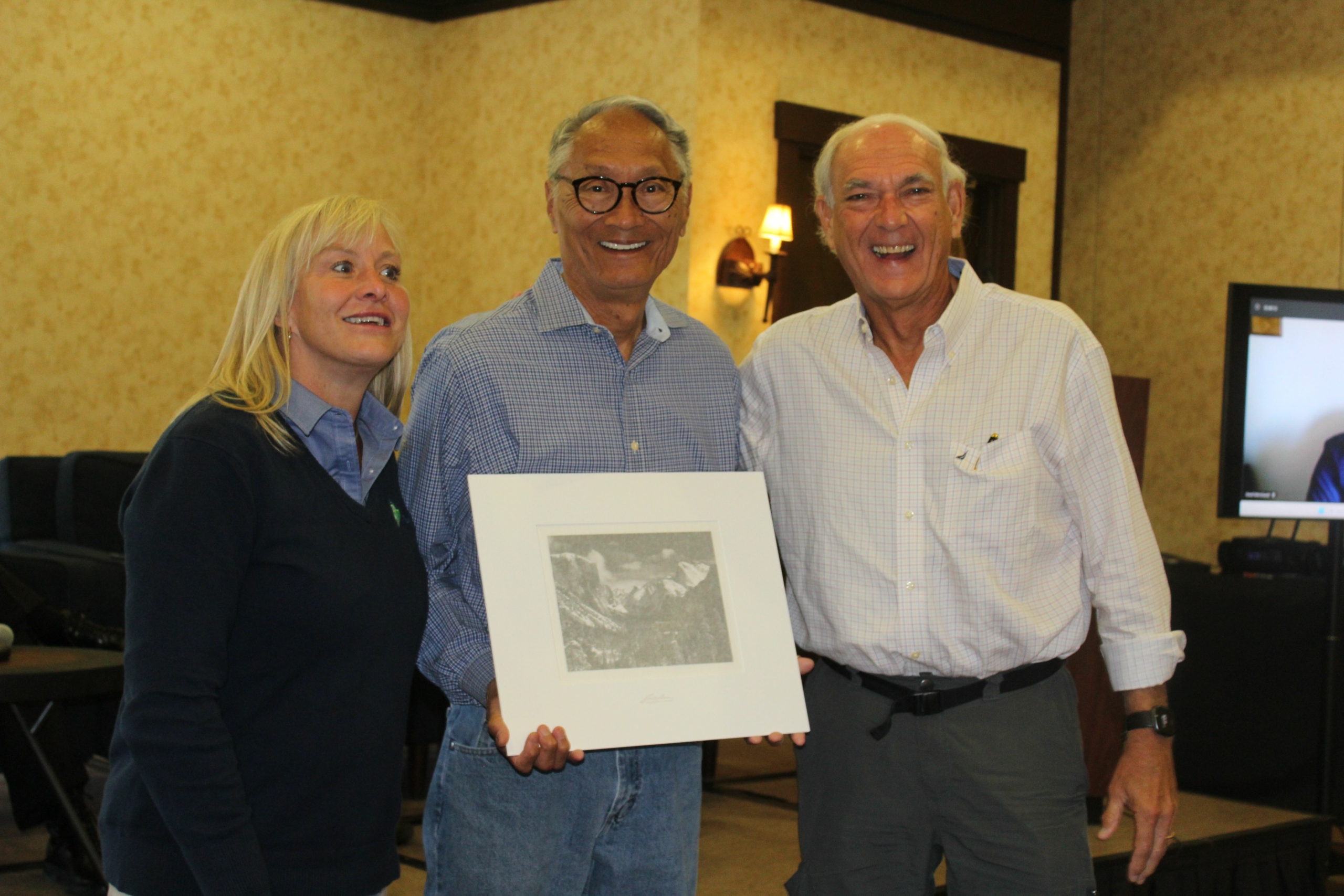 Bruce Saito with Mary Ellen Sprenkel and Derrick Crandall at The Corps Network Board Retreat, August 2023
Bruce Saito with Mary Ellen Sprenkel and Derrick Crandall at The Corps Network Board Retreat, August 2023
Q: What do you think is the future of the Corps movement and what would you like to see happen in the future?
Bruce: I might just be drunk on the notion of the Corps movement, but I see the movement continuing. I see it not only continuing but expanding because, again, those basic issues will remain constant. There are peaks and valleys. When we had the 2008 recession, and every time there’s recession for the world, state, or community, our recruitment increases. Then when things are great, we hit a valley but it’s still consistent where there’s always going to be young folks who want to serve, that want to do something good for the environment. So, I think the future is only going to get bigger and stronger, despite technology.
For us, the future is strong because our priorities don’t waver as much as some of those one-and-done companies. We’ve been spending many years on climate. There was a period, 20 or 30 years ago, where Service and AmeriCorps, in President Clinton’s administration, was big. And then that changed with administration. But we still have AmeriCorps. I think it’s because some of those AmeriCorps programs stay abreast with the changing times. And so, I think again the future is strong, but it’s critical for all program innovators to keep changing with the times. Especially now. I think with climate change people are looking to help.
Q: How does California Conservation Corps help to mitigate climate change?
Bruce: This is a good example of where we’ve adapted and changed. We’ve traditionally built trails, planted trees, developed parks, and we’ve always responded to emergencies: fires, floods and agricultural events, and the like. About 10 years ago, maybe even more, we helped pass legislation to do energy efficiency audits and retrofits at schools. That legislation ended after about five years. And now the CCC gets a small portion of the CCC’s Greenhouse Gas Reduction Fund. So, we have about 125 young folks who are doing energy efficiency audits for public buildings and nonprofit groups and then they’re turning those audits into energy efficiency retrofits.
In recent years, besides us doing energy efficiency, building audits, and retrofits, we’re now doing solar installation and electric vehicle charging stations to go with the flow and stay ahead of California eliminating all gas guzzling vehicles by 2030 or 2035.
We’ve also done a lot in fuel reduction to prevent catastrophic fires, which in turn keep carbon in the ground and in the trees. And we try to do a lot of reforestation and tree planting projects.

Q: Could you share a little bit about what you think the impact of the Corps is on young people’s lives?
Bruce: That’s one of the proudest areas that I’ve got to experience. More than 130,000 young folks have come through the CCC and that’s a cool thing. I’d like to say that many of them we’ve helped, and I hear from them that we’ve changed their lives.
Developing, progressing, and making their life better… I think that’s what we do each day. We ask young folks to bust their butts every day. We have six crews or about 80 young folks doing levee repair where there was once a dry lake, which now looks like an ocean because of last winter’s severe flooding.
Those folks are working. They get up at five, they’re at the site by seven in the morning and they don’t leave the site till five or later at night.
The crew will be out there for at least 10 days and maybe 13 or 14 days in a row. And they’re dividing the crew work up, but they’re filling 7,000 sandbags a day. So, the number just kind of blows your mind…a crew of 15, they split up and they’re filling sandbags. They’re shoveling and filling sandbags for a full day. And it’s backbreaking labor, intensive work, but it’s also monotonous and it’s like ‘Oh my gosh.’ – And that’s just the first day.
How do you sustain that? You’ve got to really build on that sense of purpose with the young folks that you’re saving property, you’re saving lives by restoring and shoring up this levee. And it may not seem like it at three o’clock in the afternoon when you’re sore and you’re on your seventh day out there and it’s hot outside, but you know, you do it. Because you know that you’re really doing something of great value.
Impact Story: Oconaluftee Job Corps Advanced Forestry Instructor comes full circle
Submitted by Alicia Bennett, Public Affairs Officer, U. S. Forest Service Job Corps
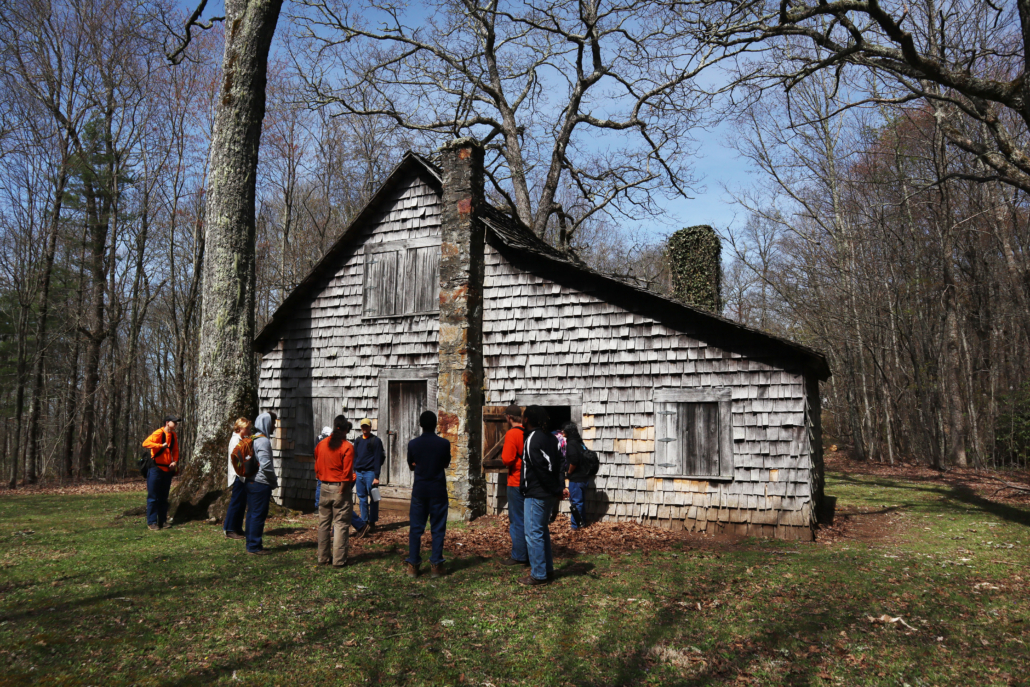
Oconaluftee Job Corps Civilian Conservation Center Advanced Forestry students visit the Wilson Lick Ranger Station, one of the first ranger stations built on the Nantahala National Forest on April 18, 2023. USDA Forest Service photo by Tavaris Evans.
Oconaluftee Job Corps Civilian Conservation Center (CCC) Advanced Forestry Instructor Tavaris Evans had a wonderful childhood growing up in Miami, Florida—maybe too much fun. After entering high school, the grades he brought home to show his parents were underwhelming. Naively, he believed that enrolling in an alternative high school would be the magic solution to help him earn his high school diploma. It did—until he stopped showing up for class.
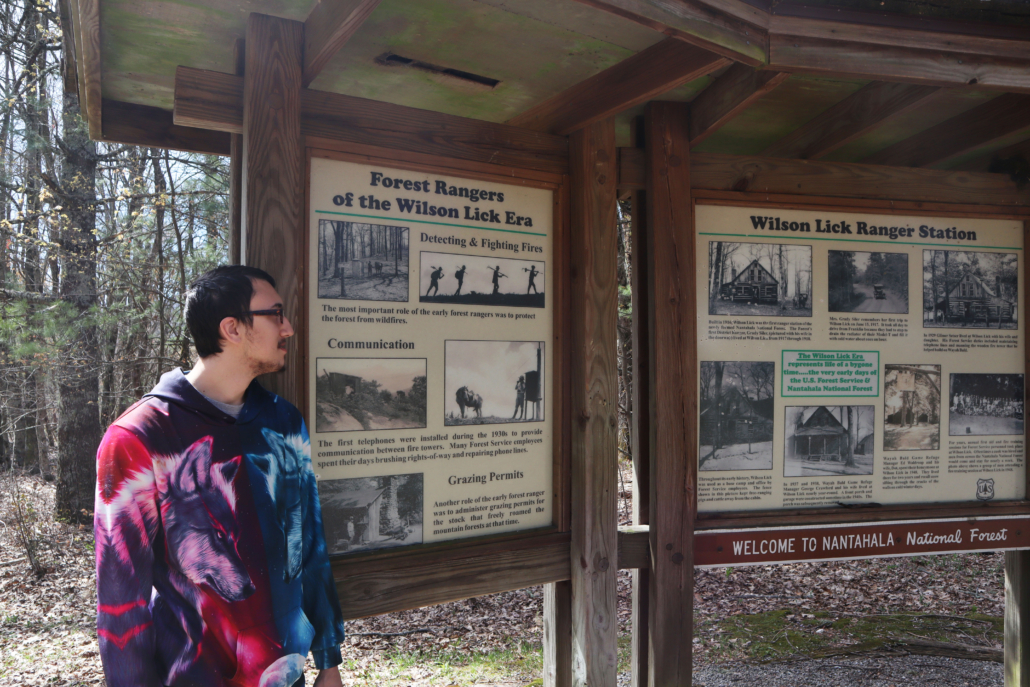
Oconaluftee Job Corps Civilian Conservation Center Advanced Forestry student Alexander Maillard reads interpretive signage at the Wilson Lick Ranger Station on the Nantahala National Forest on April 18, 2023. USDA Forest Service photo by Tavaris Evans.
Dropping out of school did not sit well with his parents. They instructed Evans that if he was not enrolled in school he had to get a job. Surveying his options, Evans discovered that his career prospects included working at warehouse, driving a truck or joining the military, none of which he found attractive. Ultimately, he did find employment at a warehouse and enrolled in a vocational school with the goal of earning his GED. But, between long work shifts and a commute he dreaded, Evans became discouraged and he dropped out of school yet again.

Oconaluftee Job Corps Civilian Conservation Center Advanced Forestry student Montel Filmore at the Wayah Bald Fire Tower on April 18, 2023. USDA Forest Service photo by Tavaris Evans.
In 2005, while working at the warehouse, Evans would pass the Miami Job Corps Center on his route home. He was intrigued enough to see what it had to offer, applied, and was quickly accepted. By November 2006 he had earned his certification in business administration but not earn a GED. Evans went back to working at the warehouse. After a year he realized two things–he had to dedicate himself full-time to his education and it had to be in a new location outside the state of Florida. After experiencing what Job Corps had to offer, he decided that it would provide him the best opportunity for success and enrolled in Lyndon B. Johnson Job Corps CCC.
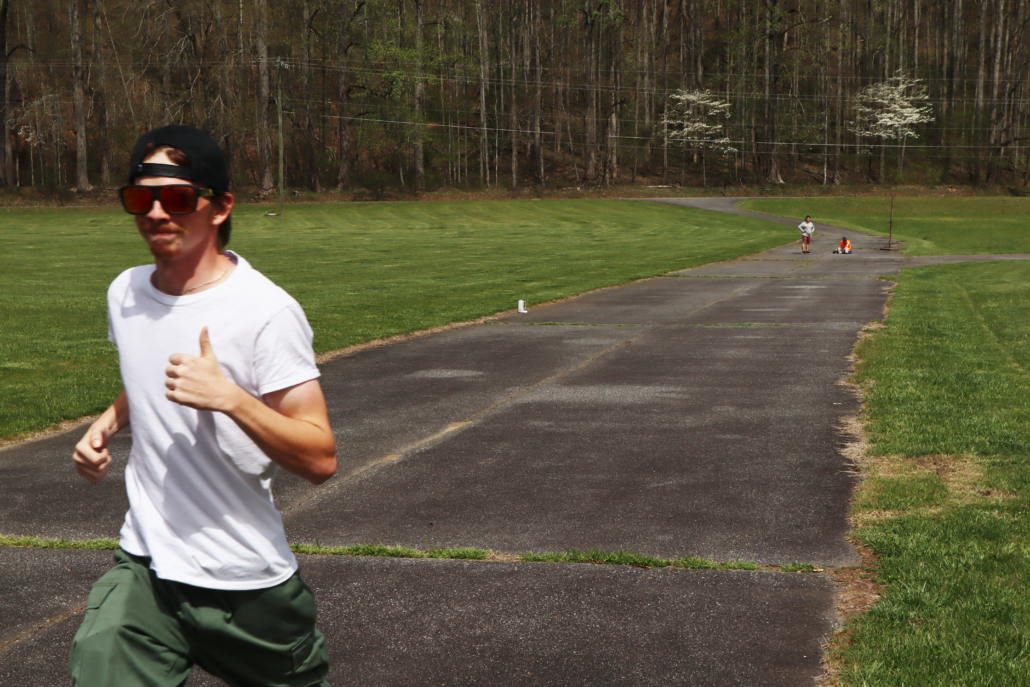
Oconaluftee Job Corps Civilian Conservation Center Advanced Forestry student Jacob Coleman participates in physical training on April 14, 2023. USDA Forest Service photo by Tavaris Evans.
Attending a Forest Service Job Corps center sparked Evan’s interest in wildland firefighting, leading him to enroll in the Advanced Wildland Fire Management Program at Schenck Job Corps. He completed his training September 2008. The extensive work experience Evans received at Schenck provided him with the skills he needed to advance to the next stage of his career. “Job Corps provided me with hands-on experience in wildland fire that was desirable for entry level placement with the Forest Service,” said Evans. “I learned a trade, got my GED and got paid for it. I made good friends and had great instructors. I am thankful for the Job Corps program—it changed the trajectory of a high school dropout.”

(l-r) Oconaluftee Job Corps Civilian Conservation Center Advanced Forestry students Dereck McEachin and Luke Schwartz sharpen hand tools on April 20, 2023. USDA Forest Service photo by Tavaris Evans.
Evans went on to work as a firefighter on the Hoosier National Forest for six years. He then moved on to the Cibola National Forest to work as an Assistant Engine Captain for eight years. Evans stumbled upon an outreach for an instructor for Oconaluftee Job Corps’ revamped Advanced Forestry Program and now he has come full circle. “I thought this is probably a good opportunity and I applied and here I am,” shared Evans.
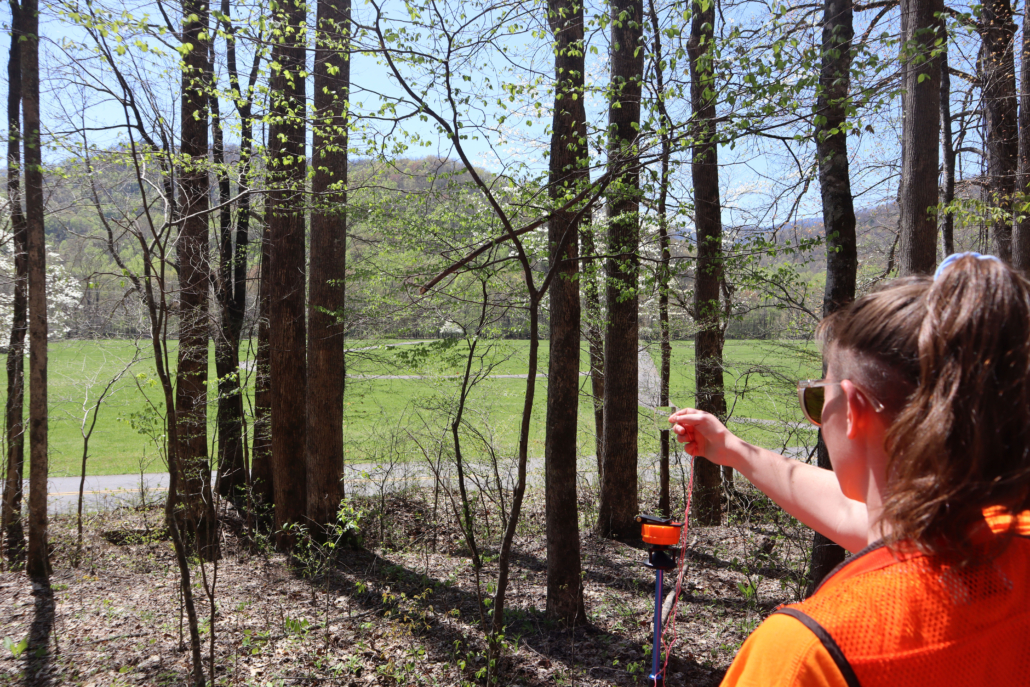
Oconaluftee Job Corps Civilian Conservation Center Advanced Forestry student Hannah Greene uses a prism to tally trees in a plot for cruising timber on April 11, 2023. USDA Forest Service photo by Tavaris Evans.
As the new Advanced Forestry instructor, Evans studied the standardized Advanced Forestry Training and Achievement Record (TAR) to expand upon and develop his own lesson plans and curriculum. “I looked through the TAR and asked myself, ‘OK, how does this look?, ’” he stated. However, immediately after his arrival, Oconlaluftee lost its forestry instructor. Evans was asked to backfill the position which required mastering its own specific TAR. “I had full class of about 15 students and I had to hit the ground running,” he said. “Before you know it I was taking students here, taking students there—I went out West and took students out to California and Nevada.” By the time Evans was able to return full-time to his permanent role, he had two Advanced Forestry students waiting. “I had to build the plane while it was in the air with students already onboard.”

Oconaluftee Job Corps Civilian Conservation Center Advanced Forestry student uses a vertex hypsometer to measure tree height on April 11, 2023. USDA Forest Service photo by Tavaris Evans.
The Advanced Forest program has a maximum enrollment of 10 students and takes six to seven months to complete. Students are trained on the basics of timber marking/timber cruising, trails, recreation and maintenance. They spend 16 weeks working on a national forest to gain experience in the field and learn how the U.S. Forest Service conducts business to serve the American public. Students who successfully complete the program earn a Public Land Corps certificate, giving them a special hiring status for future employment with the agency.
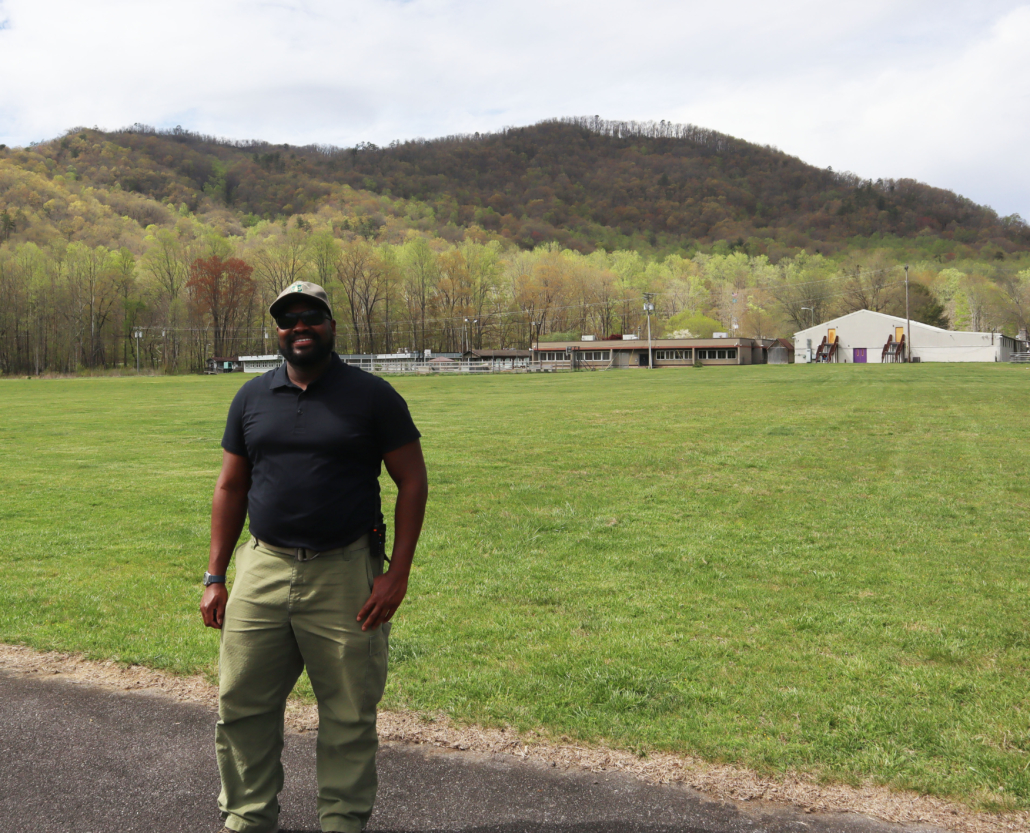
Oconaluftee Job Corps Civilian Conservation Center Advanced Forestry instructor Tavaris Evans. Self-timed photo courtesy of Tavaris Evans.
Evans continually beats the ground to find instructors to speak and train his students. “As I’m building the program, I’m reaching out to resources to ask them if they are available or if they have a project the students can work–on the national park, forest districts, with the Bureau of Indian Affairs or the state. “I want to get the students quality experience and enhance the program.”
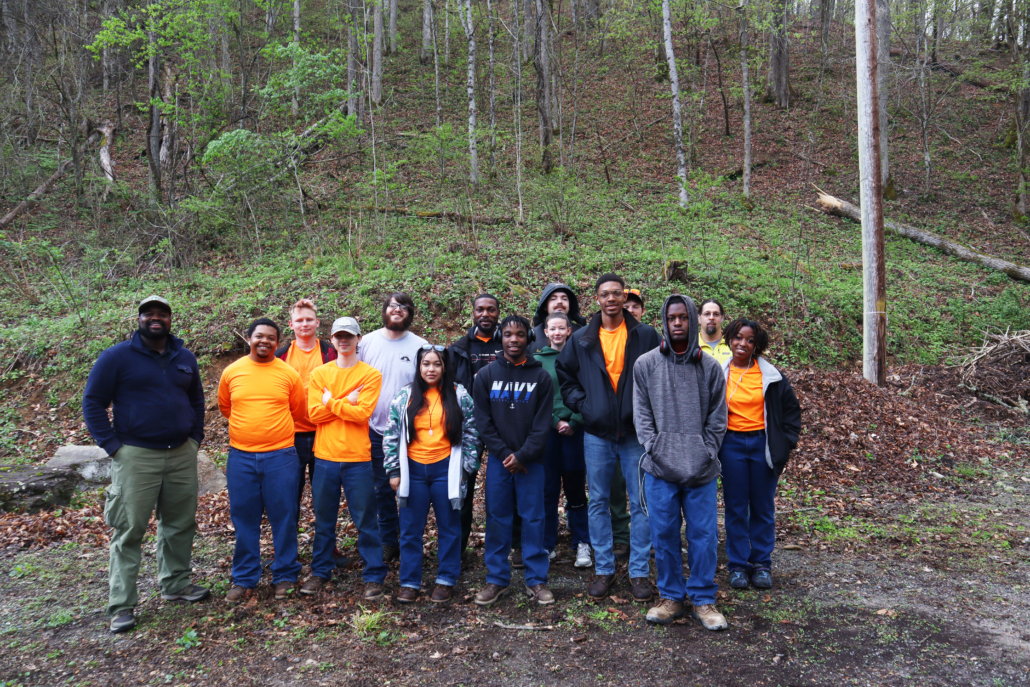
Oconaluftee Job Corps Civilian Conservation Center Advanced Forestry inaugural class on April 13, 2023. USDA Forest Service photo by Tavaris Evans.
Evan’s end-goal as an instructor is to ensure that every student in his program has the skills needed to pursue entry-level jobs in areas such as timber, firefighting, recreation or forestry. “I take them as they come,” he says. “Some know what they want to do and others are unsure and still trying to figure out it out. I put them on a path to get them to their end goal—which may require them getting more advanced training. The whole idea is to train the students and making a student employable.”

Oconaluftee Job Corps Civilian Conservation Center Advanced Forestry student Thomas Paine uses a sling psychrometer to measure the weather temperature and relative humidity on April 13, 2023. USDA Forest Service photo by Tavaris Evans.
As for where he is headed in his career, Evans does not seem to have given it much though. But the one thing he is sure of is that he wants to excel. “Whatever position I land in my career; my goal is to be great at it.”
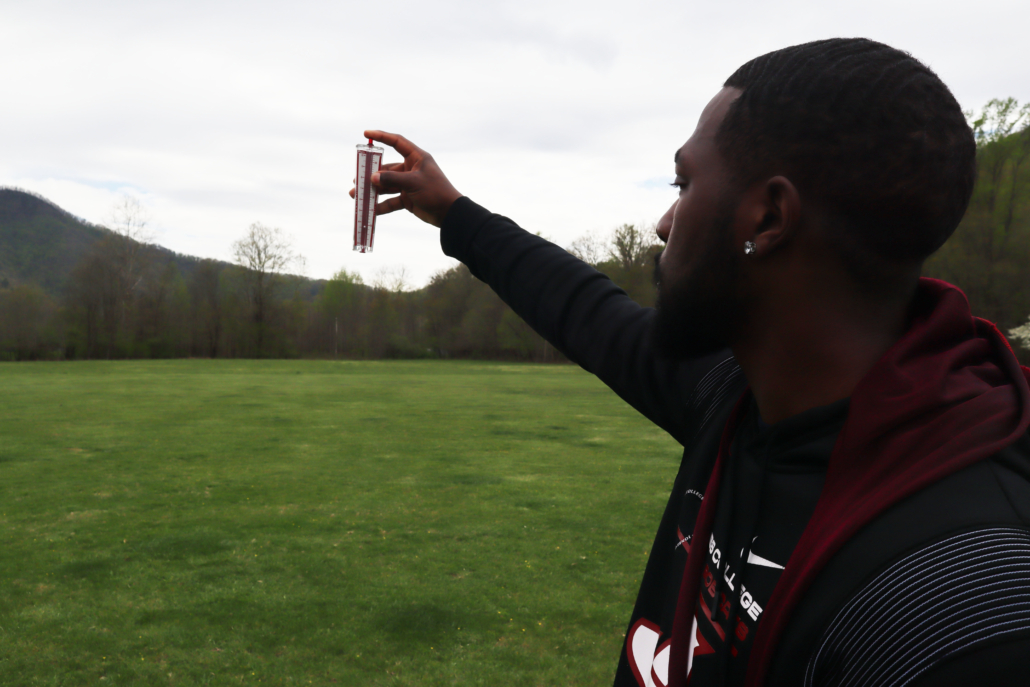
Oconaluftee Job Corps Civilian Conservation Center Advanced Forestry student Levino Sims uses a wind meter to measure wind speed on April 13, 2023. USDA Forest Service photo by Tavaris Evans.
Impact Story: What do aquatic macroinvertebrates tell Upper Delaware River Conservation Corps about stream health?
By: Edward Kim
Freshwater is one of the most, if not the most, precious natural resources in the world. Life would not be possible without healthy freshwater and the ecosystems it supports. Unfortunately, bodies of freshwater are rapidly disappearing or being contaminated due to harmful human activities coupled with climate change–but there’s hope thanks to Service and Conservation Corps.
Upper Delaware River Conservation Corps (UDRCC) is stepping up to help protect our country’s precious freshwater sources through outdoor national service projects. They’re currently leading an aquatic macroinvertebrate identification project in the Willowemoc Watershed in Sullivan County, NY to gain key insight on water quality levels from streams connected to the Delaware River.

This summer, a crew of UDRCC Corpsmembers set out to streams to evaluate its overall health through biomonitoring. In ecological terms, biomonitoring is a scientific method that studies organisms to determine the health and conditions of an ecosystem.

Biomonitoring is a scientific method that studies organisms to determine the health and conditions of an ecosystem
The Willowemoc Watershed, like many other freshwater ecosystems, teems with essential plants and wildlife. Here you’ll find numerous tree species and freshwater streams that are home to small and large mammals; cold-blooded reptiles and amphibians; residential and migratory birds; multiple fish species; and hundreds of aquatic macroinvertebrates.
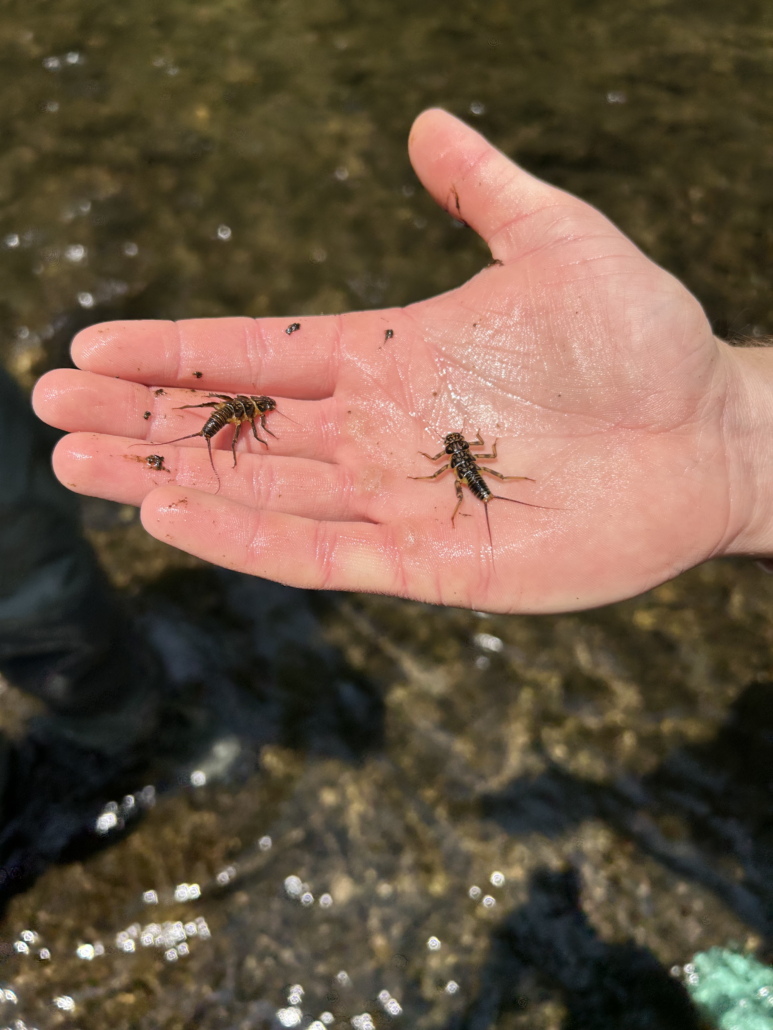
Macroinvertebrates are organisms that can be seen with the naked eye and do not have a backbone. Examples of freshwater aquatic macroinvertebrates include insects such as mayflies, caddisflies, and stoneflies, as well as the larva of certain flying insects like mosquitos and dragonflies. Crayfish, worms, snails, and clams are other common aquatic macroinvertebrates.

Despite being spineless, aquatic insects support the base of the food chain in freshwater ecosystems. They’re critical food sources for larger organisms, notably salmon and trout. Did you know that fly fishing, a popular angling technique, gets its name based on the lures resembling the enticing insects fish like to eat?
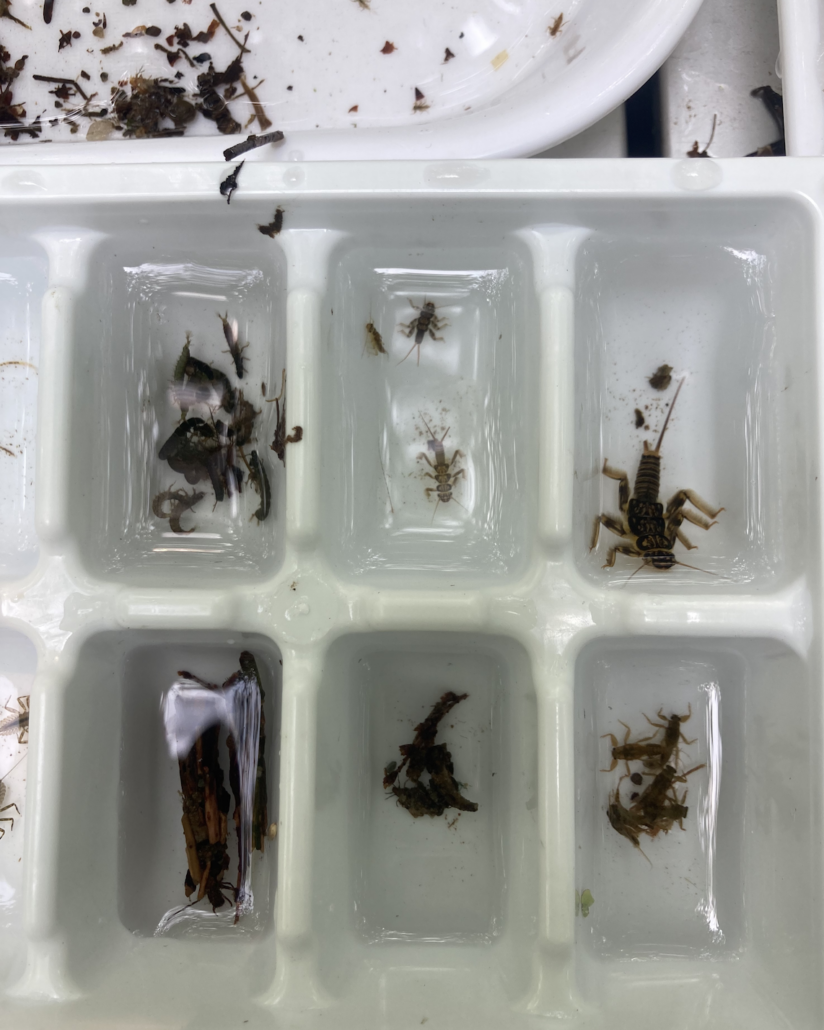
Aquatic macroinvertebrates serve as reliable indicators of water quality for UDRCC Corpsmembers to survey. In addition to being abundant and diverse, they’re also relatively easy to collect with many macroinvertebrates staying in a small area most of their lives.
More importantly, many macroinvertebrates are sensitive to changes in stream conditions–including water temperature, pollution amount, dissolved oxygen levels, types of sediment, and more–but their tolerance levels to changing conditions vary based on the species. This means determining the number and diversity of macroinvertebrates in a stream can reveal useful information about the water’s quality.
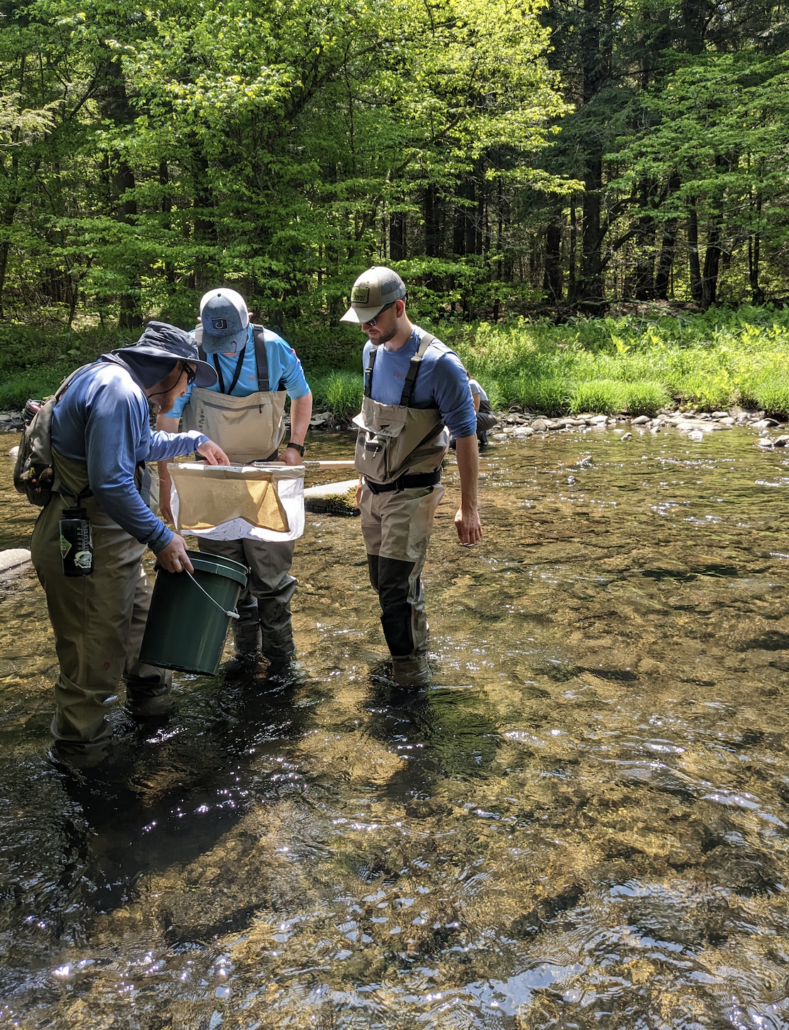
Aquatic macroinvertebrates serve as reliable indicators of water quality for UDRCC Corpsmembers to survey
So far, UDRCC Corpsmembers have sampled over 600 aquatic macroinvertebrates in several segments of the Willowemoc Watershed. The crew locates macroinvertebrates through a method called kick net sampling, which involves wading in the steam and using their feet, wooden sticks, and the current to dislodge any macroinvertebrates hidden under rocks, wood, and leaves. The critters are then swept into fine mesh kick nets resembling butterfly nets before being identified and recorded.

According to Friends of the Upper Delaware River’s Policy Director Molly Oliver, the crew, “found a species of caddisfly (rhyacophilidae) and many mayfly species that are considered key indicators of a healthy stream, including an armored baetis (baetiscidae). A giant stonefly (pteronarcyidae) was a fun find. They can get to be the size of a baby carrot or your big toe.”
UDRCC Corpsmembers have sampled over 600 aquatic macroinvertebrates in several segments of the Willowemoc Watershed
While macroinvertebrates are collected and counted, the UDRCC crew categorizes them based on their order, family, genus, and species. This information can reveal much about the stream’s health. For example, if pollution sensitive macroinvertebrates–like caddisflies and stoneflies–are identified, then the stream is determined non-impacted or healthy since sensitive species can tolerate it.
On the other hand, if a previously abundant stream shows a drop in the number of identified species or suddenly begins to offer only tolerant species, then the stream would be considered impacted or unhealthy.

“One of the most rewarding things is seeing the crew members grow throughout the season. A moment inevitably comes when everything just clicks. They see a macroinvertebrate and can identify it without having to look at a key, or they do an assessment and can complete it correctly without needing help. Those moments make this work so gratifying,” shared Oliver.
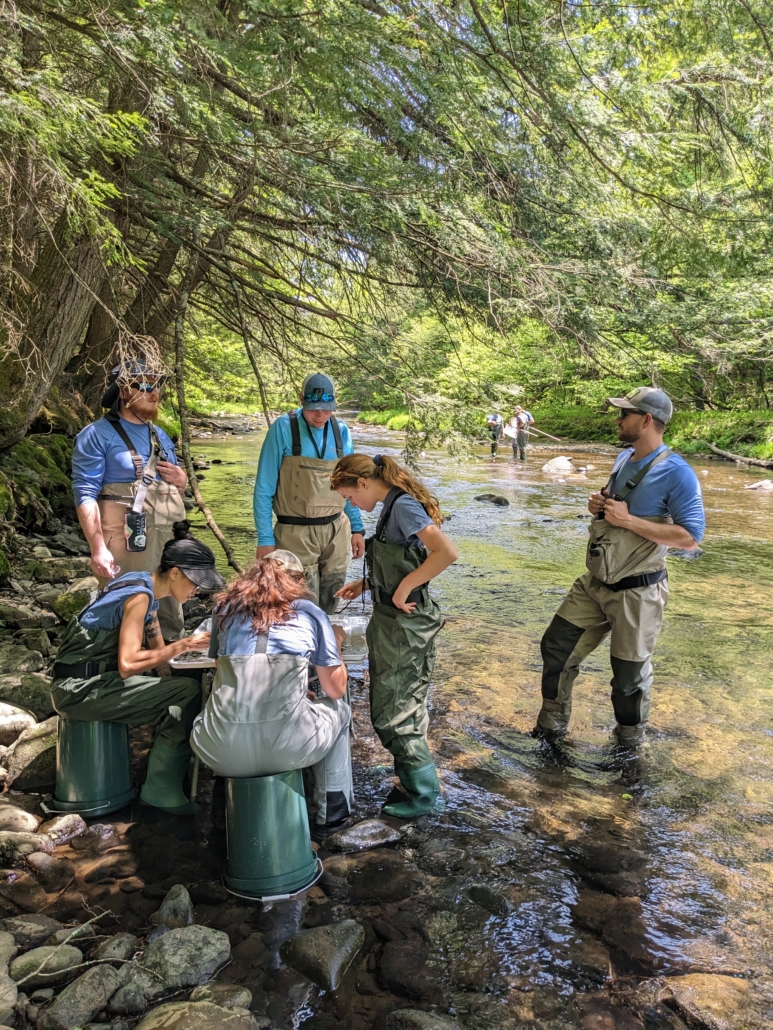
Each participating Corpsmember has worked approximately 80 hours on this project, and that number is expected to double. This currently ongoing project provides insightful data on water quality that will aid community members in properly understanding and managing waterways connected to the Delaware River. Thanks to macroinvertebrates and the information collected by UDRCC Corpsmembers, unhealthy stream sections are being identified, and future initiatives to improve water quality and stream conditions will hopefully be more effectively decided upon and implemented as a result.
As part of the Delaware River Climate Corps (DRCC) initiative, this project was made possible after The Corps Network received roughly $3.7 million in grant funding from the William Penn Foundation in 2021 and 2023. UDRCC is one of many climate and conservation-focused Corps programs part of the DRCC initiative. A regional model for a national Civilian Climate Corps, this initiative seeks to improve climate resiliency within the Delaware River Watershed by training and employing young adults in environmental careers.
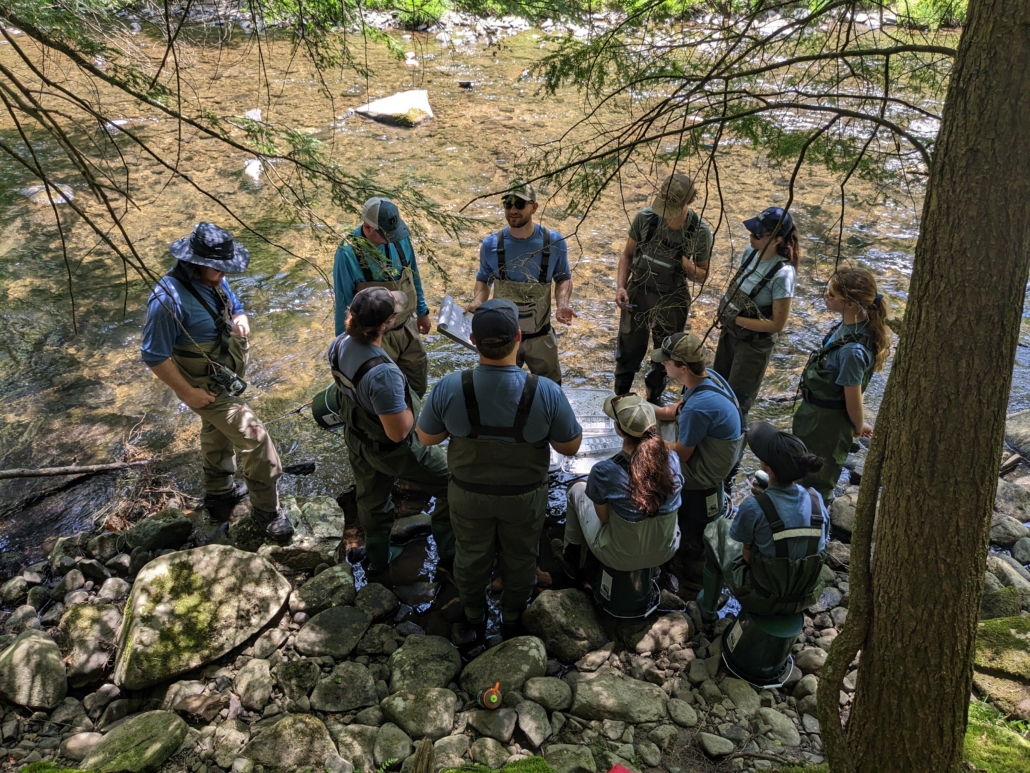
Update from The Corps Network’s Government Relations Team – July 24, 2023
By Meghan Castellano & Danielle Owen
Read this blog from The Corps Network’s Government Relations Team about recent updates from Washington and what they mean for the Service and Conservation Corps community.
Fiscal Responsibility Act (Debt Limit Law) Update
Over Memorial Day weekend, President Joe Biden and U.S. House of Representatives Speaker Kevin McCarthy (R-CA) announced that an agreement had been reached on raising the federal government’s debt limit. This legislation passed the House and the Senate by a bipartisan vote and was ultimately signed into law by President Biden on June 3. This law H.R. 3746, The Fiscal Responsibility Act averted the debt limit crisis.
What’s In the Debt Limit Law?
- The law will suspend the federal government’s $31.4 trillion debt limit until January 2025. The bill cuts non-defense discretionary spending for Fiscal Year 2024 and will limit all discretionary spending to 1 percent growth in Fiscal Year 2025. Along with rescinding close to $28 billion in unspent pandemic relief funds, the law rescinds $1.4 billion in mandatory IRS funds that were appropriated for this year in the Inflation Reduction Act. The bill will also toughen work requirements for the Supplemental Nutrition Assistance Program (SNAP) and the Temporary Assistance for Needy Families Program (TANF).
- The law also includes a procedure for passing the annual appropriations bills for Fiscal Year 2024 and Fiscal Year 2025. Congress would be required to pass all twelve annual appropriations bills by January 1 (for those two fiscal years) or there would be an automatic cut to current spending by 1 percent.
What Does This Mean for Corps?
For the Corps community, AmeriCorps is one of the agencies that will have funding rescinded from the American Rescue Plan Act of 2021 (ARPA). AmeriCorps’s unobligated funding from the ARPA – excluding ARPA funding in their Salaries and Expenses, the National Service Trust, and the Inspector General accounts – would be rescinded. The funds that are being rescinded were expected to be used through what remains of Fiscal Year 2023 and in Fiscal Year 2024 as part of AmeriCorps’s multiyear ARPA implementation plan. Below is what the rescission of these ARPA funds means for AmeriCorps VISTA and AmeriCorps State and National:
- AmeriCorps VISTA: A total of $37 million, intended to support living allowances in Fiscal Year 2024, will be rescinded. Due to this cut, AmeriCorps VISTA will not host a summer associate program in Fiscal Year 2024 and anticipates funding 500 fewer full-year member service years in Fiscal Year 2024 than in Fiscal Year 2023 (pending Fiscal Year 2024 appropriations).
- AmeriCorps State and National: A total of $28 million, which was expected to be used for competitive grant funding in Fiscal Year 2024, will be rescinded. This will reduce the number of AmeriCorps State and National positions funded in Fiscal Year 2024 by approximately 2,500 AmeriCorps members.
Fiscal Year 2024 Appropriations
How Is the Fiscal Responsibility Act (Debt Limit Law) Related to Fiscal Year 2024 Appropriations?
- While the Fiscal Responsibility Act’s immediate goal was to raise the debt ceiling so that the U.S. could avoid defaulting, it also included topline spending caps for Appropriators to use when creating their appropriations bills.
- This legislation set the non-defense discretionary spending cap at $704 billion. This is a $40 billion cut (or five percent) from Fiscal Year 2023. The Appropriations Committees will be able to reallocate unspent funds, largely from the American Rescue Plan Act (ARPA) and the Coronavirus Aid, Relief, and Economic Security Act (CARES Act), that will essentially help to keep Fiscal Year 2024 non-defense funding at flat levels.
Where Do the Annual Appropriations Bills Stand Currently?
The Fiscal Year 2024 appropriations process is in full swing in the U.S. Congress. The House is close to completing its committee action on Fiscal Year 2024 appropriations bills. Unfortunately, House Appropriations Chair Kay Granger (R-TX), in response to pressure from the far-right wing of the House Republican Caucus, has decided to draft their Fiscal Year 2024 appropriations bills at Fiscal Year 2022 funding levels and not that level set in the debt limit legislation. The Senate is drafting their bills at the funding levels set in the debt limit legislation. Below is information on what is in the House draft bills for the Interior-Environment and Labor, Health, and Human Services Subcommittees.
-
Interior and Environment (bill passed out of Full House Committee)
The House Appropriations Committee has held a full committee mark-up of the Interior-Environment draft bill. The draft bill report is linked here.
- The draft bill contains cuts to the Department of Interior (DOI) overall and at the Department’s various units. There are increases for the U.S. Forest Service (USFS) for wildland fire management. The bill does include the annual $5 million at the USFS for “priority projects within the scope of the approved budget, which shall be carried out by the Youth Conservation Corps and shall be carried out under the authority of the Public Lands Corps Act of 1993 (16 U.S.C. 1721 et seq.).”
- The draft bill’s report contains the following language:
- “Federal Corps Programs. —No funding is provided within Title I for the Department of the Interior to implement the redundant Civilian Climate Corps. The Committee supports the work of the Youth Conservation Corps and the Public Lands Corps, two longstanding Federal corps programs related to conserving and restoring public lands and waters that partner with locally based, nonfederal corps organizations.”
-
Labor, Health, and Human Services, Education (bill passed out of House Subcommittee)
As of the writing of this, the House Appropriations Full Committee has not marked up the Labor, Health and Human Services, Education Appropriations bill. There is the potential for changes to this draft bill during the full committee mark-up. As it stands, the draft bill provides $163 billion in Fiscal Year 2024 funding. This is a cut of $63.8 billion or 28 percent below Fiscal Year 2023. If this became law, it would be the lowest funding level for the Labor, Health and Human Services, Education bill since 2008.
-
-
- AmeriCorps – The draft bill would cut the AmeriCorps agency’s topline to $660.94 million. This is a fifty percent cut compared to Fiscal Year 2023. The bill would eliminate funding for the National Service Trust, which funds the Education Awards that Corpsmembers earn.
- Job Corps – The draft bill eliminates funding for Job Corps, a cut of $1.8 billion that would eliminate job training and employment services for 50,000 youth who face barriers to employment.
- Pell Grant – The bill does not provide an increase for the maximum Pell Grant award. The amount of a full-time Segal AmeriCorps Education Award is equivalent to the maximum value of the Pell Grant. If this bill became law, it would be the first time since 2012 that the maximum Pell Grant award was not increased.
- WIOA Youth Job Training State Grants – The draft bill eliminates funding for WIOA Youth Job Training state grants, a cut of $948 million that would eliminate job training and employment services for 128,000 youth who face barriers to employment.
-
Are We Headed Towards a Government Shutdown? Could There Be a Year Long Continuing Resolution?
Given the discrepancies in funding levels at which the House and Senate are drafting their spending bills it will likely be difficult for the two chambers to find common ground. Fiscal Year 2023 ends on September 30, 2023. Congress has until then to pass an Appropriations package. If they are unable to do so they may pass a Continuing Resolution to keep the government funded at current levels until a decided end date. It is important to keep in mind that the debt limit legislation, signed into law in early June, also includes a provision that would reduce defense and non-defense spending by one percent from current levels if all twelve full-year appropriations bills are not completed by January 1, 2024.
If by the end of September 30, 2023, no agreement is reached to pass an appropriations package through both chambers of Congress and signed into law by the President or no Continuing Resolution is passed through both chambers and signed into law by the President, a federal government shutdown would occur.




